my london diary
London and London events, from 1999 to now.
All pictures on this section of the site
are © Peter Marshall
2017;
contact me to buy
prints or for permission to reproduce pictures or any other questions and
comments.
my london diary index
Feb 2017
Hounslow Heath
Dubs Now - let the children in
25th anniversary of Khojaly Massacre
Stop Unfair Eviction by Guinness
Picturehouse recognition & living wage
Shut race-hate LD50 gallery
End homophobic bullying at LSE
Hull 2017 City of Culture
Sculcoates & River Hull
City Centre & Beverley
Rd
Ropery St & St Mark's Square
St Andrew's Dock
Hessle Rd
Gipsyville
Beverley and Nellie's
Around the Town
The Deep
More Hull Panoramic
Wincolmlee and Lime St
Evening in the City
Old Town
A ride on Scale Lane Bridge
Around the City Centre
Hullywood Opening
East Hull & Garden Village
Albert Dock
Old Town & City Centre
River Hull
Night in the Old Town
Victoria Dock Promenade
Show Culture some Love
Willesden Green Wassail
Kensal Rise to Willesden Green
ANAL squat in Belgravia
Invest in Cycling - Stop Killing Cyclists
Dubs Now - Shame on May
King's College Divest Oil & Gas Now!
Court support for Heathrow protesters
No Muslim Ban, No State Visit
january |
 |
Other sites with my pictures include
london pictures
londons industrial history
hull photos
lea valley / river lea
and at my blog you can read
>Re:PHOTO my thoughts on photography.
All pictures Copyright
© Peter Marshall 2017, all rights reserved.
High res images available for reproduction -
for licences to reproduce images or buy prints or other questions and comments,
contact me. Selected
images are also available from Alamy
and Photofusion
Hounslow Heath
Hounslow, Middx. Mon 27 Feb 2017
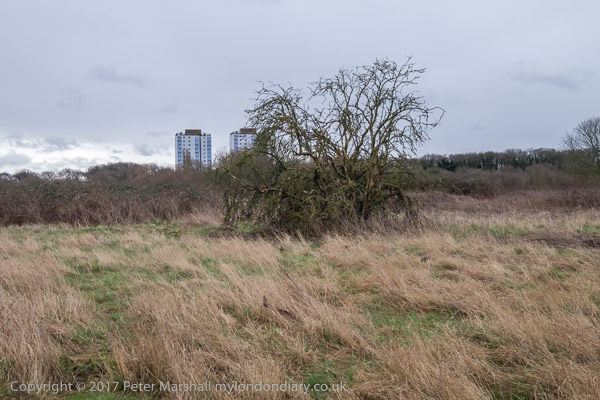
Only a few areas of Hounslow Heath still look more
or less as they used to when I played there as a boy
more pictures
Although it was a dull day and rain was promised, we decided to go for a walk on Hounslow Heath.
I wasn't quite born on the heath, but spent quite a lot of my boyhood playing there, at a time when it was largely rough grassland, full of trenches from when it had been in use during wartime as a military training area. We would fight our own battles in these trenches, and there was always the chance of finding the occasional souvenir from those exercises, though fortunately none turned out to be live. In one corner was a firing range, where concrete buildings had been blown to pieces, and we rode our bikes on races around muddy paths in a circuit - when bigger youths weren't using them as a motorbike course.
Years before I was born, my father had played on that same heath, and gone
to watch the early aircraft that came into London's first airport there
- and to get told off for touching one of them - he always thought it was
by Bleriot, but I think probably another of the other earlier aviators.
Since I moved away from Hounslow - really since I went to university in
the early 1960s - I've hardly been back to the Heath - just walked across
a corner of it on the London Loop, though I've often cycled past or gone
by along the Staines Road on the top of a double-decker, so decided it would
be worth a visit on one of our family walks.
It stopped raining briefly for us to start, though there were some large puddles to walk around. Though much of the Heath has survived, large areas have changed greatly. The western part was dug for gravel and then became a public golf course, but we were in the eastern half, which has mainly become a kind of nature reserve.
Before there were just small areas of woodland and scrub, mainly around the edges but now these seem to cover most of the area, and it is no longer much like the old Heath I used to know. It still makes for a pleasant enough walk, though it would have been better without the rain which came on rather heavily for the last half mile or so as we made our way around one the recommended route. I don't think any of the fences that we walked by and certainly none of the gates we walked through were there when I was young - we roamed freely over the area. And certainly there were no boards explaining the wildlife that we largely didn't see. I preferred it the old way, before we had conservation and management.
But one improvement was in the local pub. You could not have found a decent
(and cheap) Indian buffet in the Hussar or anywhere in the area back then.
Not of course that in my early years we ever ate out, or went into pubs,
but pub food then was limited to at best crisps, peanuts and pork scratchings.
more pictures
Dubs Now - let the children in
Downing St, London. Sat 25 Feb 2017
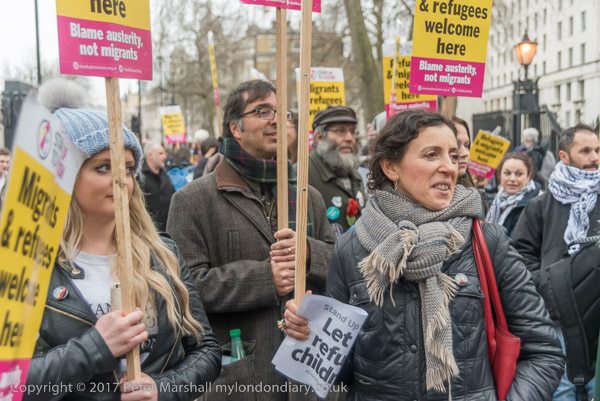
Migrants & refugees welcome here say the placards
- but no the racist government
more pictures
Help4Refugee Children protest at Downing St calling for the UK Government to honour its promise to let unaccompanied Syrian children into the UK after it reneged on its pledge earlier this month.
Parliament made its view clear passing the Dubs amendment and the government's
shameful and heartless decision overturns this, leaving many vulnerable
young children forced to continue living in intolerable conditions. Many
local councils have made offers to take the children but these have been
ignored by government.
more pictures
25th anniversary of Khojaly Massacre
Westminster, London. Sat 25 Feb 2017

The marchers pause in front of Parliament
more pictures
A march to Parliament in London commemorated the 25th anniversary of the Khojaly Massacre in Azerbaijan and called for justice.
On the night of 25-26 February 1992, Armenian forces brutally killed 613 civilians in the town of Khojaly, including 106 women and 83 children. Refugees fleeing the town which had been surrounded by Armenian forces were attacked and unprotected civilians slaughtered; many were scalped or otherwise mutilated.
The Justice for Khojaly Campaign aims to compel the Armenian Government to make an official apology, make full reparations and bring those responsible for war crimes to justice. Armenia still occupies around 20% of the internationally recognised territories of Azerbaijan despite UN Security Council resolutions calling for unconditional, immediate and full withdrawal of its forces.
Historically the position is complex. The whole area was a part of the Persian Empire and was ceded to Russia following wars between Russia and Persia in the early 19th century. After the Great War and the Russian Revolution, a northern area became a part of the USSR, while the area historically known as Azerbaijan was annexed by Persia and is now still part of Iran, now known as South Azerbaijan. The area to the north was briefly independent before becoming part of the USSR - and since 1981 is again independent as the Republic of Azerbaijan. Some Azerbaijanis claim all of the areas with an large Azerbaijani population, including all of Armenia and parts of Dagestan, Georgia and Turkey as 'Whole Azerbaijan.
In September 1991, the majority Armenian population of the Nagorno-Karabakh
region seceded to form the Nagorno-Karabakh Republic, leading to a war which
ended in 1994 with an uneasy truce which has left Nagorno-Karabakh de-facto
independent. The Khojaly massacre was the largest massacre in the course
of that war.
more pictures
Stop Unfair Eviction by Guinness
Brixton, London. Sat 25 Feb 2017
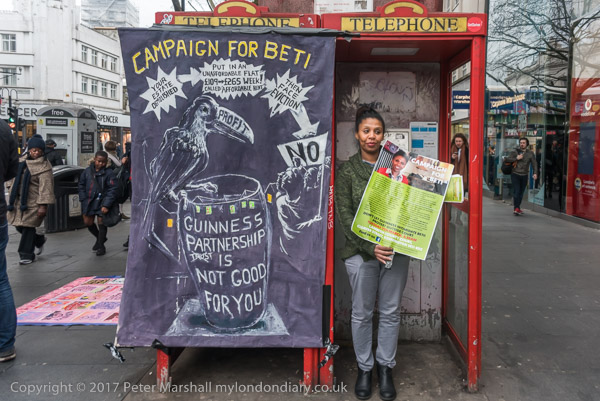
Betiel Mahari poses with a poster about the campaign
to stop her eviction and get a fair rent
more pictures
Supporters of the 'Save Beti Campaign' including Fight Racism! Fight Imperialism! and Architects for Social Housing campaigned outside Brixton Station collecting signatures for a petition to oppose the eviction of Beti and other tenants threatened by estate demolition.
Betiel Mahari was evicted from her home in the demolished Loughborough Park Estate and her rent in a new flat was raised from £109 per week to £265. Because her work is on a zero hours contract, her housing benefit claim is constantly being reassessed causing delays and errors in payments and making her in arrears. The Guinness Partnership are now taking her to court seeking a possession order to evict her and her two young boys. Guinness charge her neighbours £100 pw less for similar flats.
While in Brixton I also took some more pictures of the railway arches,
some now boarded up but others still refusing to move and keeping trading.
more pictures
Picturehouse recognition & living wage
Leicester Square, London. 25 Feb 2017
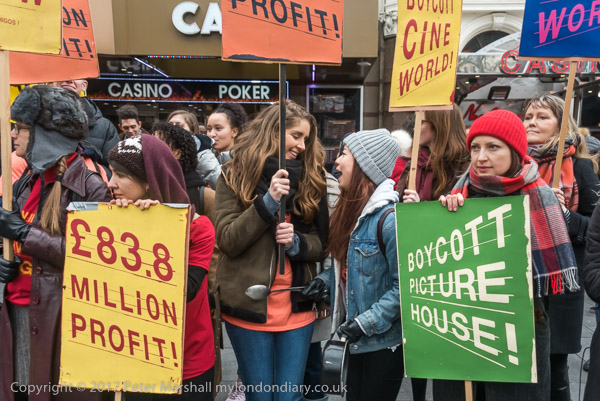
Picturehouse workers hold placards calling for a boycott
of Picturehouse cinemas
more pictures
Workers from four Picturehouse cinemas at Brixton, Hackney, Wood Green and Picturehouse Central meet outside the Empire Cinema in Leicester Square to campaign for recognition of their union BECTU and to be paid the London Living Wage.
The protest, timed for tomorrow's Oscars ceremony, started outside the
Empire Cinema in Leicester Square, newly acquired by Cineworld, the owners
of Picturehouse Cinemas. Cineworld offer employees a company run staff forum
rather than recognising trade unions and fail to pay their London staff
a living wage or provide decent conditions of service, despite large profits
from cinema-goers paying £13 or more to see a film. The staff are
striking for £9.75 per hour, while Mooky Greidinger, CEO of Cineworld
gets around 60 times as much.
more pictures
Shut race-hate LD50 gallery
Dalston, London. Sat 25th Feb 2017
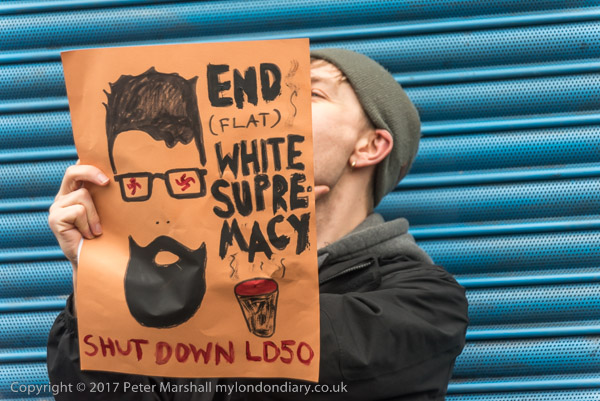
'End (flat) White Supremacy - Shut Down LD50' poster
more pictures
Several hundred people from East London gathered outside the LD50 gallery in Dalston which they say has promoted fascists, neo-Nazis, misogynists, racists and Islamophobes in one of London's more diverse areas.
They say the gallery, whose name refers to the dose of any substance required to kill 50% of those taking it, "has been responsible for one of the most extensive neo-Nazi cultural programmes to appear in London in the last decade."
The protesters want the gallery to be closed, but one man came to argue
that the right to freely discuss ideas, even repulsive ones, should be defended,
and was shouted at by protesters; eventually police took him aside and advised
him to leave.
more pictures
End homophobic bullying at LSE
London School of Economics, London. Fri 24 Feb 2017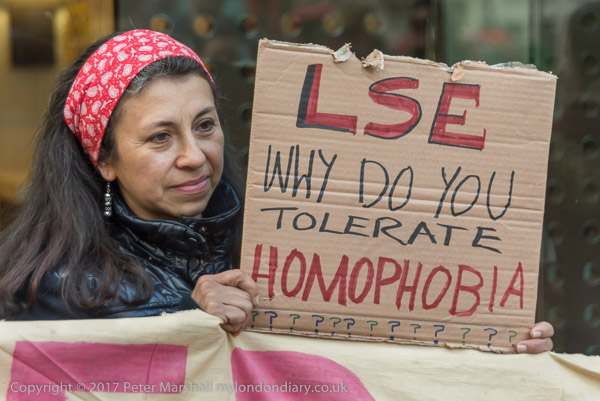
A woman holds up a poster 'LSE Why do you tolerate
Homophobia????????????
more pictures
Cleaners union United Voices of the World and LSE students protested at the LSE over the failure of cleaning contractor Noonan and the LSE to respond to the homophobic bullying of a cleaner.
The cleaner, known as 'Sam', submitted a formal grievance over two months ago following incidents which the protesters say amount to a hate crime. Richard Seddon, account director for Noonan's LSE cleaning contract, was dismissive of his claim and Sam approached the UVW union. They approached LSE Interim Director Julia Black and the directors of LSE facilities department but no action was taken.
The UVW say Noonan have now admitted that they "let things slip"
but neither they or the LSE have yet taken proper action. The noisy protest
demanded that Seddon be removed from supervising the LSE cleaners and that
the cleaners be treated with dignity and respect, and demand they get the
same terms of employment as if directly employed by the LSE.
more pictures
Hull2017 City of Culture
A 'My London Diary' special supplement
Sculcoates & River Hull
Hull. Mon 20 Feb 2017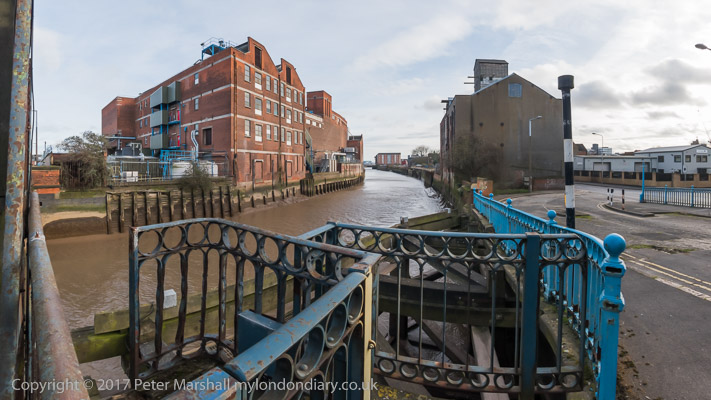 Scott St Bridge and the River Hull
Scott St Bridge and the River Hull
more pictures
I particularly wanted to return to Scott Street bridge where I had taken
a number of pictures the previous morning as strong winter sunlight from
a low angle had prevented me from photographing down river. This afternoon
conditions were fine, and I was able to take a number of pictures in the
area before I had to return to the city centre.
more pictures
City Centre & Beverley Rd
Hull. Mon 20 Feb 2017
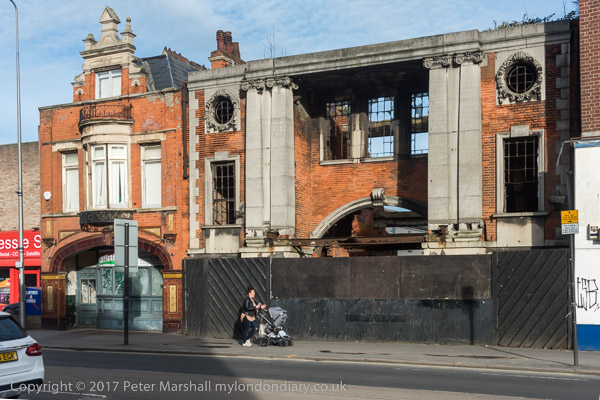
The last Blitzed civilian building in the UK, Hull's National Picture Theatre
more pictures
Campaigners are still fighting to keep the ruins of The National Picture Theatre on Beverley Rd as a memorial to the Blitz, as it is though to be the last blitzed civilian building in the UK still remaining as a ruin. When the air raid siren sounded, there were 150 people inside watching Charlie Chaplin's 'The Great Dictator' and unable to reach a shelter they took refuge in the cinema foyer. Although a parachute mine exploded and demolished the cinema itself, all those in the foyer survived. The building was listed Grade II in 1994 and has so far survived nine planning applications for various conversion and/or demolition. The current owners appear to be waiting for it to completely fall down.
My walk took me along Ferensway and briefly up Springbank before heading across to Beverley Rd. After photographing the theatre ruins I headed east down FOuntain Rd towards the industrial area on the west of the River Hull.
Later I returned to the city centre, hoping to see a photographic exhibition
at the City Library, but unfortunately although the library was open the
exhibition area closed a couple of minutes before I arrived. Later I was
able to get into some other exhibitions (although two of them had also closed
- most things seem to close early in Hull) but people kindly opened up a
show of sixth-form and student photography at Hull College and the Sarah
Lucas show at the Humber St Gallery after hours for us. The COUM Transmissions
show upstairs at the gallery was still open and we spent some time there,
though I found it's deliberate sexual provocation rather childish. We also
made an unauthorised visit to the gallery's rooftop terrace, destined to
become a bar to admire the nighttime views of Hull, before going down to
the ground floor bar to admire Hull's iconic 'Dead Boyd' graffiti, preserved
there behind perspex.
more pictures
Ropery St & St Mark's Square
Hull. Mon 20 Feb 2017
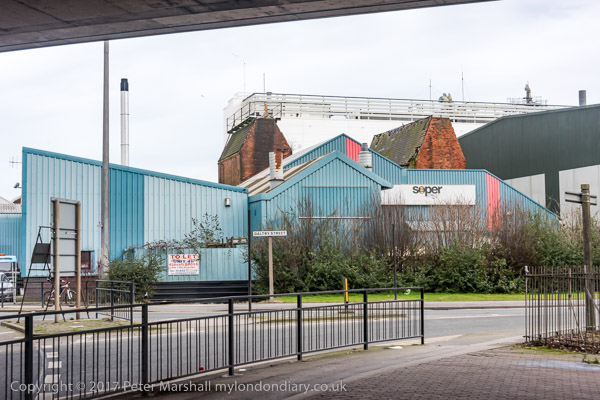
Daltry St still has the remains of two of Hull's smokehouses
more pictures
Next to the Smith and Nephew works in Daltry St are two of Hull's remaining smoking sheds. The best view of them would almost certainly be from Clive Sullivan Way, but it isn't easy to stop there to take pictures.
There are two more former smoke houses in the area, and also some other places I wanted to photograph, and we had to have lunch at Aunt Sally's on the corner of St Mark's Square in Edgar St, hard to beat for value even in Hull. Of course there isn't a great deal of choice and you really have to eat the day's 'special' - which was homemade Chicken Parmo (a north-east speciality) with Salad & Chips for £3.75 and very tasty and very filling.
After lunch I spent a little time wandering around the area looking for places to photograph, then headed off towards the city centre along English St.more pictures
St Andrew's Dock
Hull. Mon 20 Feb 2017
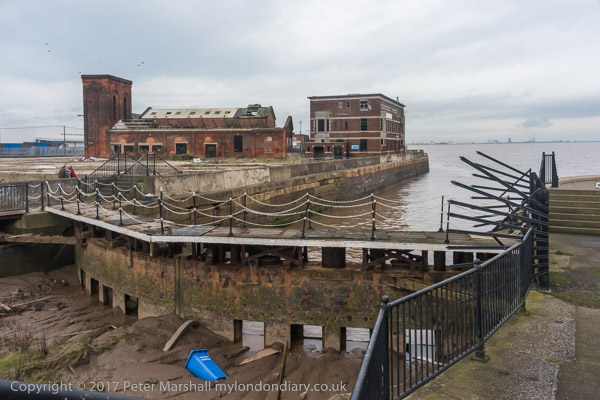
The footpath here (Transpennine Way) used to go across
the lock gate, now fenced off
more pictures
St Andrew's Dock was the old Fish Dock, whose presence was strongly felt when the wind blew its smell across the north of the city where we stayed with my wife's parents. It closed in 1975, when what was left of Hull's fishing fleet moved to Albert Dock, closer to the city centre.
Part of the old dock was filled in and is now a retail centre, St Andrew's Quay Retail Park, a pretty bleak experience. The rest of the dock is silted up and is an open waste with a a few large remaining dockside buildings rapidly rotting away.
At the southwest of the dock gate is the 'Bullnose' which trawlers passed as they left the dock. There is a small monument there erected by The Royal Antediluvian Order Of Buffaloes (RAOB) to lost trawlermen, but the area has deteriorated since it was erected and the company owning the area went bust. A new and larger memorial was dedicated at a different location not far away earlier in February, but I didn't have time to visit this.
There have been new plans to develop the Dock as a themed Heritage Dock,
with the dock as a marina, a business centre and a larger memorial area,
retaining the large and currently derelict Lord Line building, but it remains
to be seen if anything like this will be realised.
more pictures
Hessle Rd
Hull. Mon 20 Feb 2017
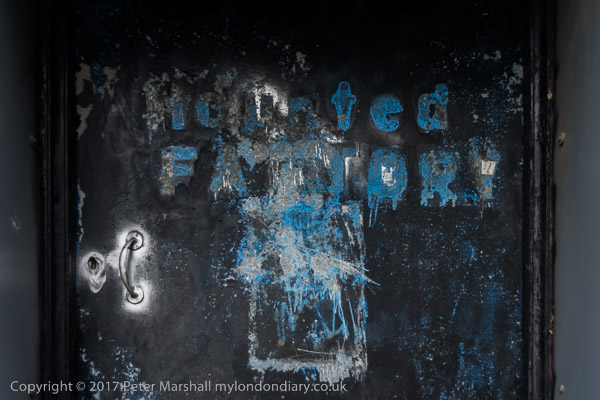
Haunted Factory, West Dock Ave
more pictures
We took the bus over the railway towards town and got off at Asda and then walked down Gillett St to West Dock St, as I wanted to go to St Andrew's Dock.
When we came out back on to West Dock St we made our way back to the Hessle Rd up West Dock Ave and then continued on into town.
more pictures
Gipsyville
Hull. Mon 20 Feb 2017
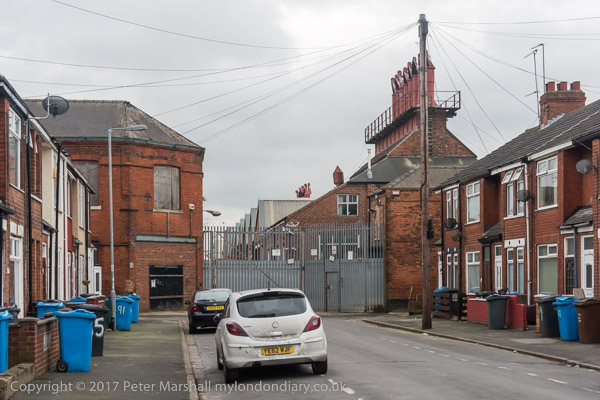
Cawoods have moved to Grimsby and the gates are
locked
more pictures
I was trying to visit as many of the locations where I had photographed back in the 1970s and 80s for the show and the book 'Still Occupied - A View of Hull' and which I'm currently putting on the 'Hull Photos' web site, a day at a time throughout Hull's year as UK City of Culture.
And one of these was Gipysville, which my notes describe as follows:
The Dairycoates (Gipsyville) Industrial Estate is a couple of miles west of the city centre and was purpose-built with 8 streets of terraced housing named after English counties running south from the Hessle Rd around 1900. THe first companies there were F. Atkins & Co making canisters (later they became part of 'Metal Box' and then moved away) and Hargreaves Bros, & Co, a black lead company, whose "Gipsy Black Metal Polish" gave the whole area its name, including the extensive inter-war council housing to the north. The industrial estate was enlarged in the 1980s, with large factory sheds of little interest.
Cawoods fish curing works were the most distinctive part of the estate, and they produced dried salted fish in Hull for around a hundred years. Their Grimsby factory came later, and they moved all production there in 2002, a few years before the Hull fish market closed.
Most of the pictures I made on this occasion were colour panoramas.
more pictures
Beverley and Nellie's
Beverley. Sun 19 Feb 2017
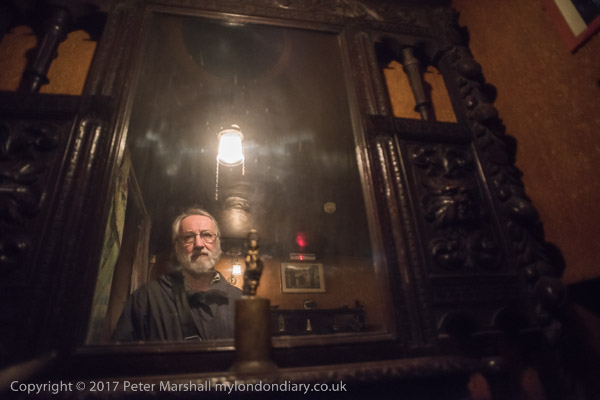
Selfie by gaslight in Nellie's
more pictures
The bus service from Hull to Beverly may be slow and rather infrequent (and a long circuit of Beverley's ring road doesn't help) but it has the advantage of setting you down at the bus station immediately next door to Nellie's.
If you've never visited, it's worth a trip to Beverley to do so. The building
was Grade II* listed in 1950 when it was said to be of medieval origin but
refronted in the 17th century. A date given to us for it being built was
1543, but it was certainly a coaching inn by the seventeenth century.
When I first went there, the pub was still run by Nellie, and rather than
a bar, beer was served by her or her sisters from a table. One of the few
things that Samuel Smiths who bought the pub from the family changed was
to install a proper bar, though it's pretty much in keeping with the rest
of the interior, which is largely still in the nineteenth century or earlier.
But it has recently got some rather modern and clean toilets.
Otherwise it's still the same rabbit-warren of rooms, almost impossible to find your way around, with some interesting furniture, much of which doesn't seem to belong in a pub. And the lighting is by gas, glowing rare earth mantles which give a soft light; there used to be one room where candles supplied the only light as the gas lighting had stopped working - but Sam Smiths have refitted it with gas lighting.
The beer - a wide range from the Old Brewery in Tadcaster - still seems remarkably cheap and is certainly more varied than I've seen in a pub for a long time - and I took the opportunity to try a pint of the Dark Mild.
But though I'd have been happy to stay there, sitting in pubs isn't Linda's
thing, though I thought this place - the best museum in Beverley - should
have been a treat. But we had to go on a walk and went as far as the Minster
before it was time to return and catch the bus back to Hull.
more pictures
Around the Town
Hull. Sun 19 Feb 2017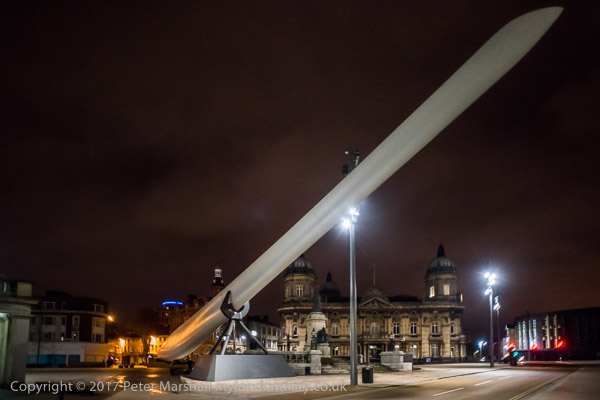
Victoria Square and The Blade at night
more pictures
We walked from The Deep to Hull Interchange, a well-designed bus station
addition to the side of the railway station, now just Hull rather than Hull
Paragon, and decided to take a bus to Beverley. It's not a great service
on a Sunday, and the train would have been a lot quicker, but we were not
in a hurry.
Later we got the bus back to Hull and I took a few more pictures as we walked
back to Victoria Dock Village. Most of the centre of Hull is really incredibly
empty at night, and we had Victoria Square pretty well to ourselves. There
are people in some of the pubs around, but otherwise it seems like a ghost
town.
more pictures
The Deep
Hull. Sun 19 Feb 2017
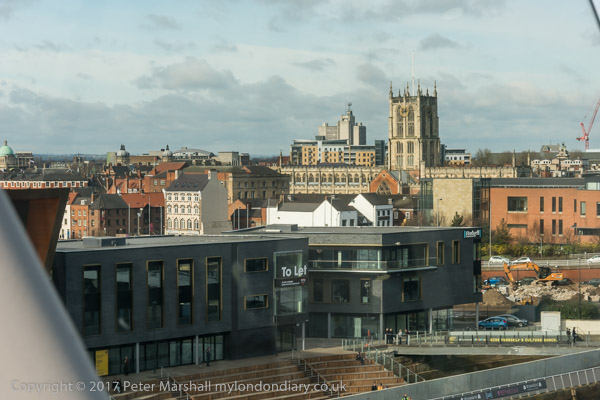
Hull from the viewing area in the cafe
more pictures
The younger generations of our family had spent the morning in The Deep, while I wandered Hull and Linda went to church and gossip, but we had agreed to meet the others for lunch at the Deep cafe.
I can't recommend the food, though at least it was fairly cheap, but they
served some of the worst cooked vegetables I've had the misfortune to meet,
along with barely acceptable chips and a rather tasteless stew. But it is
certainly worth a visit for the views of Hull and the Humber. But stick
to cakes and lemonade.
You don't need to join the queues or pay to go into the cafe, so it should
be on everyone's list of things to do when visiting Hull even if you are
not drawn in by the penguins (the latest attraction there.) On the upper
floor of the cafe is an outside viewing platform, mostly behind slightly
dirty huge sheets of tinted glass, but with a small central area which gives
clear view from more or less the tip of the building.
We were fortunate with the weather, but I can imagine it sometimes gets
rather cold and windy out there - and probably has to be closed for safety.
Even on a beautiful day, sunny and warm for February, and dressed for the
time of year I didn't want to stay outside too long. But you get a good
view from inside too.
more pictures
More Hull Panoramic
Hull. Sun 19 Feb 2017
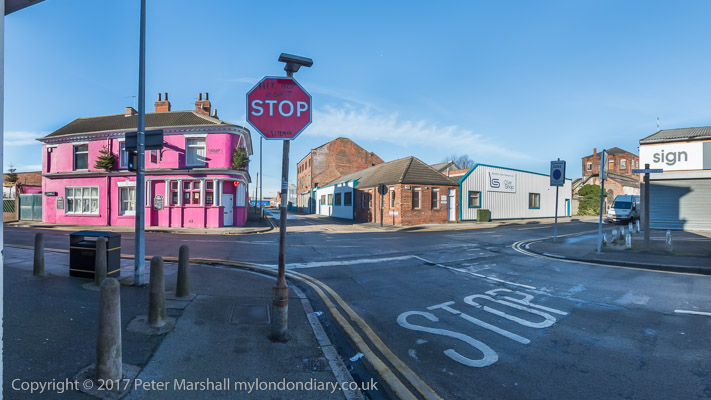
I'd come to Hull partly to celebrate Linda's birthday but also both to try and generate some interest in my photographs of the city from the 1970s and 80s, and to work on a new project which will probably combine my older black and white work with new colour panoramic images of Hull today.
So my route on this and some other walks was very much linked to some of
the places I photographed back then, though I've photographed some new places.
There were a lot of these pictures and I've separated them from the other
pictures I took during the day. These panoramas really deserve - and may
get a web site of their own.
more pictures
Wincolmlee and Lime St
Hull. Sun 19 Feb 2017
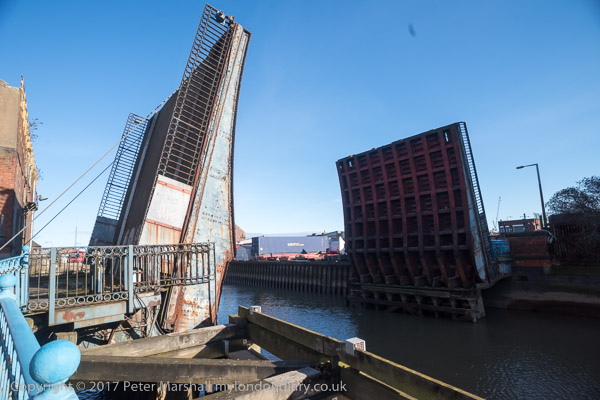
Scott St Bridge, built in 1901 and a listed building ,has been closed to
road traffic since 1994
more pictures
Sunday morning I was out bright and early and made my way up by the River Hull past Drypool and North Bridges and on to Wincolmlee. Although there was still fairly heavy traffic on Garrison Road, nothing much was moving in the rest of Hull and I was able to stand in the middle of major roads and take pictures without fear of being run over. It wasn't that early, but Hull was surprisingly empty.
Wincolmlee runs alongside the west bank of the Hull, and Hull's first commercial and industrial development was all based on the wharves around the river, at first in the Old Town and then further north into Trippett and then Sculcoates on the west and Drypool on the east.
Many of those riverside wharves have now gone, though some riverside industry remains, and many of the old premises have found new uses, though quite a few, including some interesting Victorian buildings have been demolished.
I walked up, with a few detours as far as Air St, then realised was in
danger of being late for meeting up with my family for lunch, and had to
hurry back, taking a different route though the industrial back-streets
and across Sculcoates Bridge and back down Lime St.
more pictures
Evening in the City
Hull. Sat 18 Feb 2017
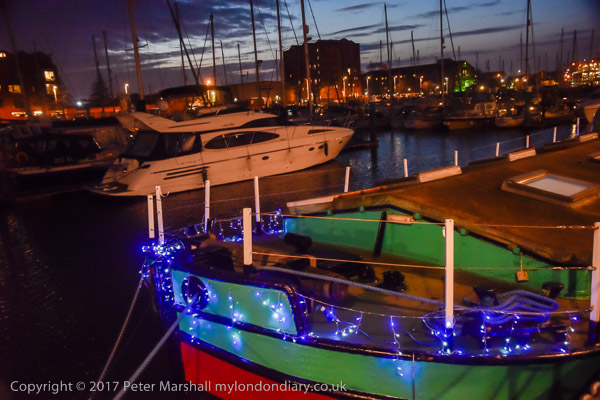 The
marina probably looks best at night
The
marina probably looks best at night
more pictures
I met up with some of the family again for a late afternoon tea in a bookshop, then as it was beginning to get dark walked on my own a long way round to a chain Italian restaurant where one of my sons had booked a table for all eight of us on the basis it was 'family-friendly'. I suppose it's a public service to take your kids who might scream to a place that's already full of screaming kids.
It wasn't really quite dark enough to appreciate one of Hull's other art
works on my way to the restaurant, different coloured lights on the walkways
of various blocks of flats. It's a nice idea, brightens up the place a little,
but perhaps only crawls onto the bottom rung as art. It does look better
when it's really dark and seen from a distance.
more pictures
Old Town
Hull. Sat 18 Feb 2017
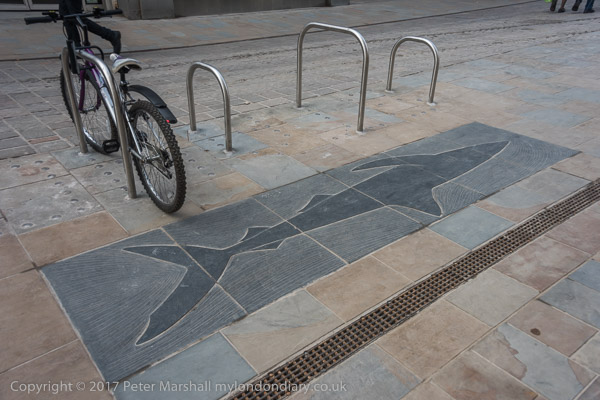
Hull had a fish trail some years back but I think
it just had small brass markers but this is now being replaced
more pictures
I had a few things to do and people I hoped to meet, but things didn't really work out, but they kept me moving back and forwards through the Old Town and to the centre of the city.
I met up with family again, went with them to the Maritime Museum and the
Streetlife Museum. Followed a little of the Fish Trail with and without
them; unfortunately quite a lot of it isn't finished yet. Had a steak bake
from Cooplands and a pint in the Lion and Key between times. Photographed
part of Hull's largest artwork in Trinity Square...
more pictures
A ride on Scale Lane Bridge
Hull. Sat 18 Feb 2017
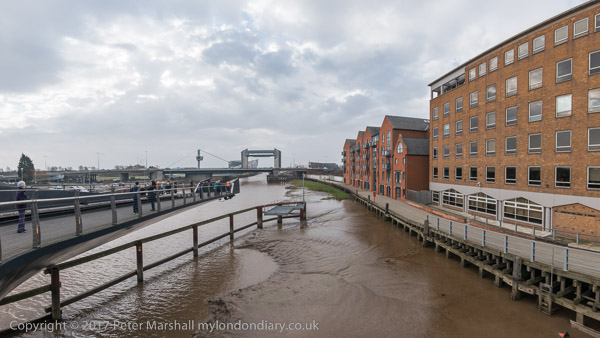
The bridge swung round and was now heading towards
the TIdal Barrier
more pictures
I managed to get my coffee at the Ferens in time to head for Scale Lane bridge, which was due to open at 11.00am. A board close to the bridge says that when it was built it was the only swing bridge that people were allowed to ride on while it was opening, and that had seemed to good a chance to miss.
Unfortunately there are seldom if any ships now large enough to need the bridge to swing - and only a few boats that are small enough to pass underneath without it opening. While 35 years ago the RIver Hull was a busy highway, it now sees hardly any movement.
But once a week on a Saturday, the bridge is operated largely to see that it is still in working order - or perhaps simply as a largely unsung visitor attraction. The time apparently depends on the tide, presumably so that were a ship to want to come through there would be sufficient depth of water, and certainly it was fairly close to high water when I arrived a few minutes before the opening was due.
I was rather sceptical that it would happen, with only a small notice in a window on the bridge announcing the next opening for 'Saturday 11.00'. There was no date and it could have been there for months. But as it due towards the time, another dozen or two people arrived, obviously like me expecting it to happen.
Two men in High-viz with walkie-talkies arrived, one stationing himself at each end of the span. I watched as one closed a pair of grey gates near the end of the approach ramp from close to the Holiday Inn and then walked onto the bridge to close a black pair at the end of the span. Then fairly slowly and very smoothly the bridge began to swing around and in two minutes the end had reached its furthest point, close to the west bank, and immediately began to move back to the starting positions.
It happened quickly and quietly and was perhaps a little disappointing, lacking a sense of spectacle. I'd expected a bell or a trumpet to sound, some whirring and flashing and had hoped (with little expectation) for a ship to appear and make its way up or down river. We all walked quietly away and I felt it was something of an opportunity lost for some suitable artistic performance.
It was probably a mistake to photograph it only as panoramas and I would
really have liked a second camera body with a longer lens to take pictures
as well. When the bridge was back in place, I walked off and back to meet
the family, taking a leisurely stroll through the Old Town and a few more
pictures.
more pictures
Around the City Centre
Hull. Sat 18 Feb 2017
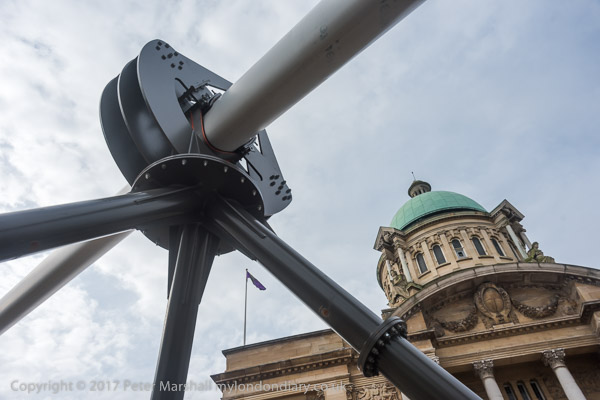
A monster from 'The War of the Worlds' was striding
towards the City Hall
more pictures
Saturday was largely a family day for me and I took relatively few pictures. We met at the Ferens Art Gallery, where I enjoyed the special exhibition on Ferens himself rather more than Bacon's Screaming Popes and the other images on display.
Ferens was a remarkable man, apparently giving away 94% of his income as
boss of Reckitt's and religiously travelling back from London to Hull to
teach his Sunday School class. He had the good sense not just to give the
city an art gallery, but also to give the gallery a bequest that enables
them even now to buy new art (though some of the more modern work that they
have bought recently seems a little trashy.)
But the gallery certainly has a fine collection, better than that of most
municipal galleries, and there was a temporary exhibit with a huge number
of works by Hull artists for their annual open exhibition, including some
very accomplished works as well as others less so. Being Hull, it also has
a room full of maritime paintings (a few of which I rather liked) now in
the room where I had a show of my work back in 1983, when the top floor
of the Ferens was a cafe area.
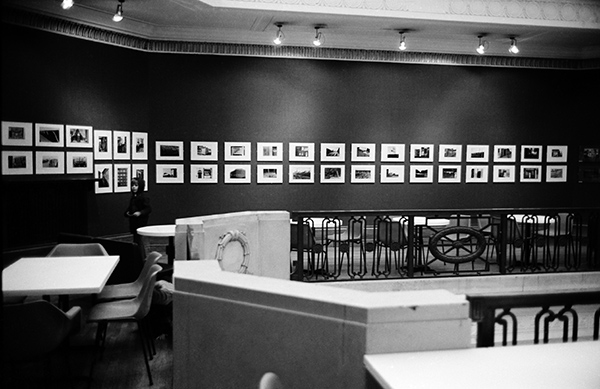
Installation View: Still Occupied - A view of Hull,
1983 had a total of 146 prints
I'd travelled over from Sheffield with family and a friend (who was also
a friend of the Ferens) to see the show on the gallery wall, and although
I'd taken a camera with me, ran out of film after I'd taken the first few
pictures. As well as this double run of 40 singly framed images, there were
some larger frames with groups of two or four small images - a total of
I think 68 images. At the extreme right of the image above are the first
pair of 38 colour images. These were mainly rather intense close-ups, dark
and rather gloomy Cibachromes. I still have most of the original prints
from the show, and probably somewhere the slides from which I made the colour
prints, though I suspect the prints will have aged better.
The cafe at the Ferens is rather larger now, and on the ground floor, but
despite the expensive re-design still seems incredibly inefficient. Back
in the old days there was little choice but you didn't have to wait the
twenty minutes it now seems to take to get a coffee.
more pictures
Hullywood Opening
Hull. Fri 17 Feb 2017 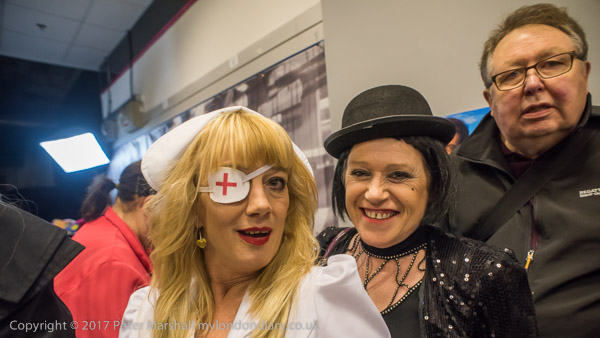
Some had come in costume to the opening of 'Hullywood
Heroes'
more pictures
Hull International Photography (HIP) in the Princes Dock Shopping Centre
was holding the opening of the show 'Hullywood Icons' by lens based artist
Quentin Budworth, whose project has inspired many others in Hull to dress
up and pose around the area in scenes intended to recreate iconic moments
from Hollywood films.
It was certainly evident from the many images in the display outside the
gallery that the project had generated a huge response from photographers
and subjects in Hull and that they had a great time producing the pictures
- and the opening was a great social occasion.
more pictures
East Hull & Garden Village
Hull. Fri 17 Feb 2017
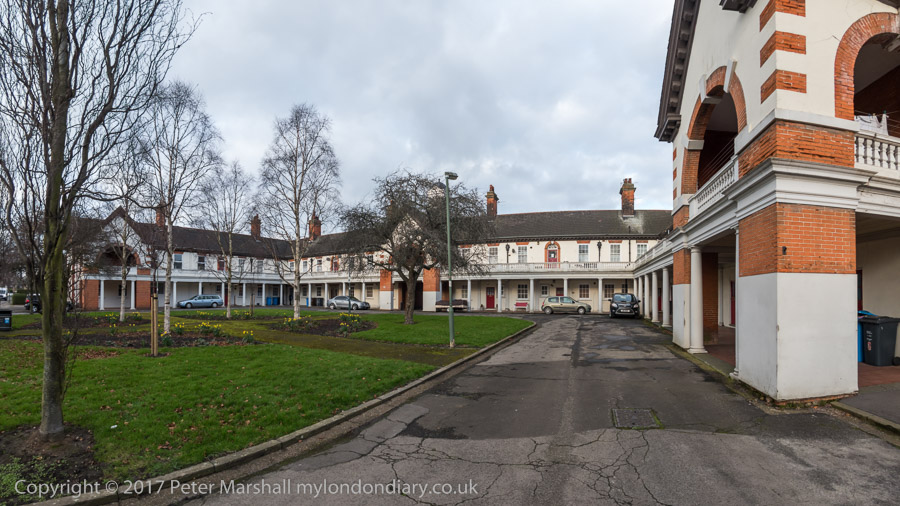
The Garden Village Shopping Centre - rather short
of shops
more pictures
We walked along Witham and then took a bus a mile or two down Holderness Rd, getting off by misunderstanding around three-quarters of a mile before we intended and walking this to get to the small British Oil and Cake Mills 'Garden Village' of 1921, just three streets and a roughly circular open space, the Bowling Circle, a development obviously stimulated by Reckitt's Garden Village a mile or so closer into town.
Another bus took us back to Laburnum Avenue, which we walked up to take a walk around that more expansive development, around 140 acres, two thirds funded by Sir James Reckitt and two-thirds reserved for workers at his nearby factory in Dansom Lane, a short bicycle ride of around half a mile to work. He set up the Garden Village Company as an independent company and bought the Holderness House Estate, north of Holderness House in 1907, and the first houses were occupied the following year, with an extra area being added with houses built by Reckitts in the 1920s. Holderness House was bought by the great Hull benefactor T R Ferens, a Hull MP and a director of Reckitts to prevent development in its grounds and keep the 'rus in urbe' character of the Garden Village.
Again this development has a central open space, The Oval, but also a smaller triangular space, 'The Playground' , with no roads around it. The road layout is much larger and more complex, along with extensive tenfoots, and we found it easy to get lost. Unlike the small BOCM development, it was provided with various facilities, including a club house, a shopping centre, and three almshouses (with a fourth a short distance away on Holderness Rd) and later on the fringe of the estate, a large church.
Visually the estate I think works best in the narrower streets which Pevsner
rather sneered at, and the wider open spaces such as the Oval are less convincing.
The most interesting building is perhaps the shopping centre, now lacking
shops. The estate company, whose profit had been limited to 3%, was ended
in 1950, with some houses being bought by tenants and the estate being sold
to the Bradford Property Trust; Hull Corporation took over the open spaces.
The area was made a 'Conservation Area' in 1970.
Having walked around much of the estate, we made our way back to the Holderness
Rd, walking a short distance along that to a bus stop, getting off at Clarence
St and walking back to the house we were staying at in The Haven.
more pictures
Albert Dock
Hull. Fri 17 Feb 2017
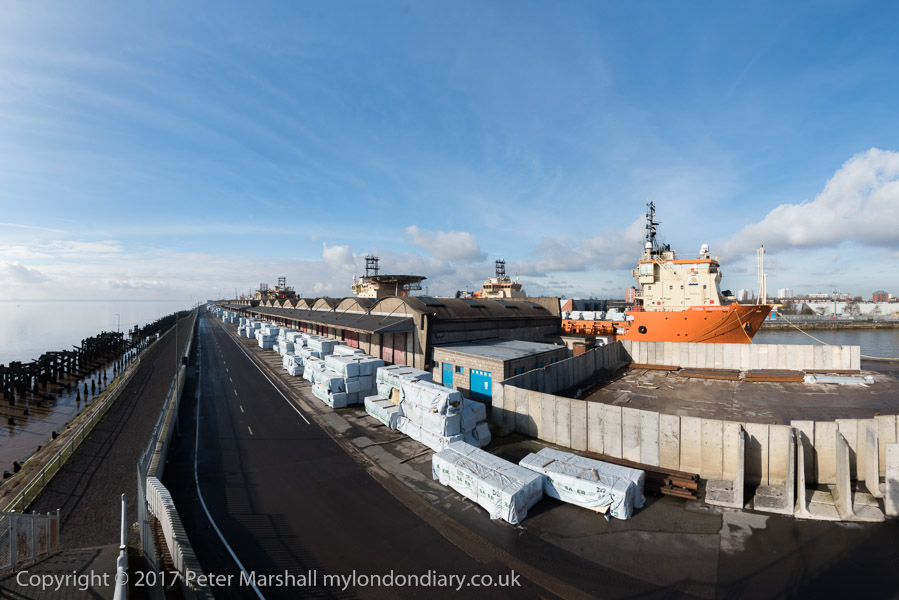
The public footpath along by the Humber is a part of the Trans-Pennine Trail
more pictures
The Albert Dock, built in 1869, became Hull's Fish dock in 1975 when St Andrews Dock as closed, but within a few years the fishing industry had left Hull.
The orange vessels now present in the dock are now involved in servicing
oil rigs and wind turbine installations, and the dock is also an important
training centre for oil rig crew.
The public right of way beside the Humber was kept when the dock was opened
and later when dockside sheds were built, and is now a part of the Trans-Pennine
Way. There are two routes across the dock entrance, either across the inner
dock gate or over a swing bridge at the outer gate. This used to be a large
steel bridge which could take large lorries, but is now just a footbridge.
The footpath then goes up steps to the top of one of the lang sheds and
continues along its top and across to the next range of sheds, before coming
down to ground level. It gives extensive views across Hull, the Albert Dock
and the Humber.
more pictures
Old Town & City Centre
Hull. Fri 17 Feb 2017
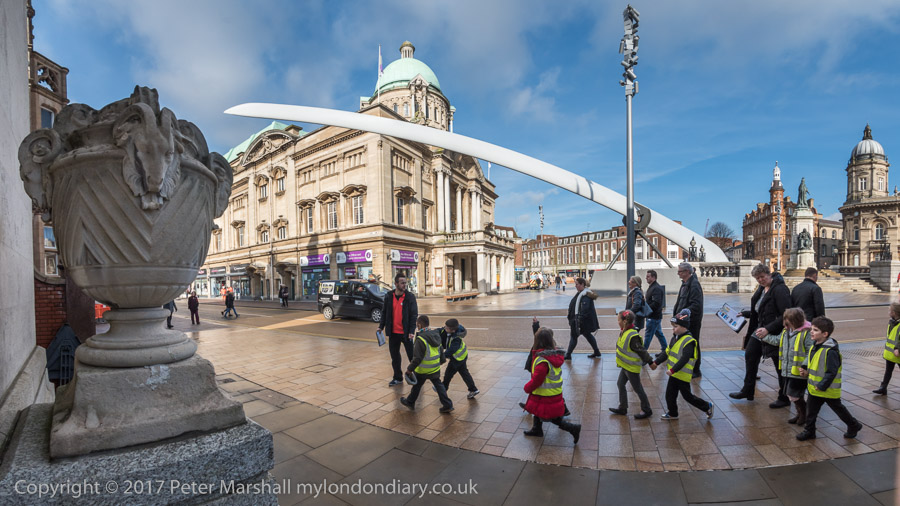
I couldn't not take a picture or two of the 'Blade'
in Queen Victoria Square
more pictures
From Scale Lane Bridge I walked towards Queen Victoria Square, making a few small detours on my way. I stopped there to make a few pictures of the square with the giant wind turbine blade in it, then headed towards Albert Dock.
Later I came back to have lunch at the Lion and Key in High St and took
a few more pictures before visiting the Street Life Museum.
more pictures
River Hull
Hull. Fri 17 Feb 2017
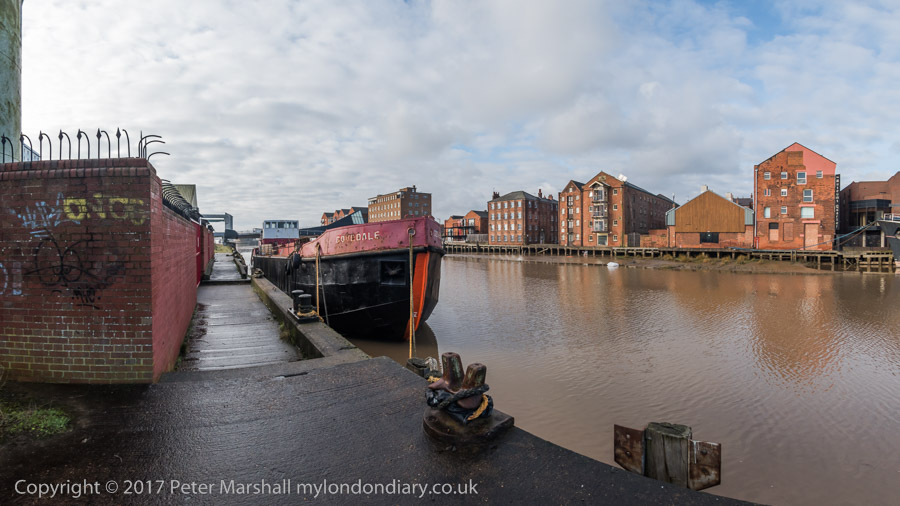
This was Hull's original harbour on the River Hull
- and was still full of barges and boats 30 years ago
more pictures
I took a detour along the bank of the Hull on my way into the city centre
in the morning and made a number of panoramic images. After lunch I walked
up from the Museums area along High St and Dock Office Row to North Bridge
and photographed the former dock entrance and dry docks there, and later,
as darkness fell, we went back across the river on the way to Princes Quay
and the HIP gallery.
more pictures
Night in the Old Town
Hull. Thu 16 Feb 2017
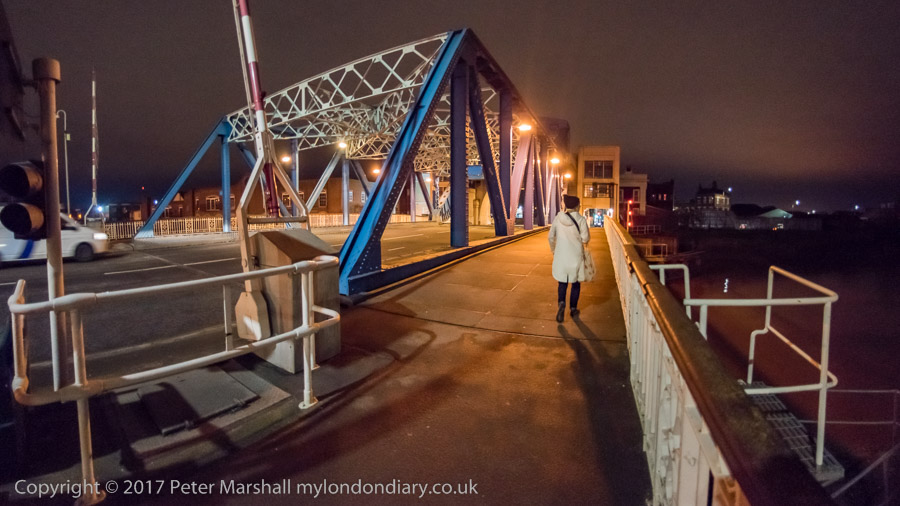 North
Bridge. Perhaps a more interesting artwork than that Blade?
North
Bridge. Perhaps a more interesting artwork than that Blade?
more pictures
After a rather decent meal and a beer or two at the Minerva we took a wander around the Old Town. As usual we waited an age to cross the A63 Castle St. If only the planners had had the foresight to raise this a few feet further from the Myton Bridge so there could be paths underneath. There were recently plans for a footbridge, but that would still be a barrier - and presumably has been ruled out on cost grounds.
The Market Square (now called Victoria Square as it no longer houses an open market 3 times a week) was covered with squares of orange barriers - perhaps Hull's most prominent art work so far this year, virtually city-wide. It might look good when it is finally finished (and it should be by the time I publish this.) But like Prince Street I think it may be too twee for my taste.
Hepworth's arcade was of course closed, but I still photographed it, and we made our way onward to Queen Victoria Square to see that Blade. It was big. Definitely big. But... well, big. I couldn't help wishing for some graffiti on it.
Getting away past huge areas of those orange barriers wasn't easy, and
we had to retrace our steps a few times before we made it to North Bridge,
and walked along the path along the east bank of the Hull down to Drypool
Bridge, and the gaping empty socket where Clarence Mill should be, only
to find that section of the riverside path closed off. We made our way back
to the house in Victoria Dock along the streets, with several minutes of
waiting at crossings to get across that A63 again.
more pictures
Victoria Dock Promenade
Victoria Dock, Hull. Thu 16 Feb 2017
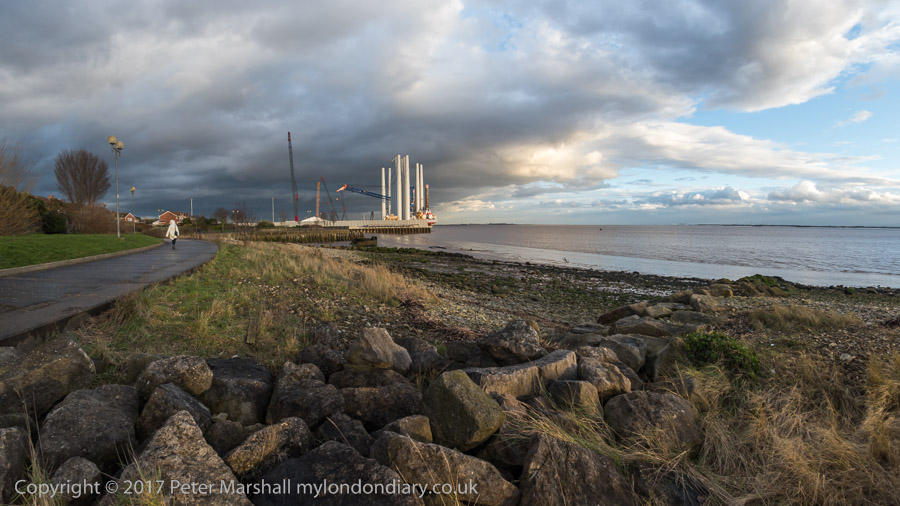
Dramatic light and clouds over the Humber in East
Hull
more pictures
We had come to Hull, partly to celebrate Linda's birthday, but also for various photography related reasons and were staying in a house built on the former Victoria Dock, which was mainly a dock for timber brought into Hull across the North Sea. All of the dock and the two large timber ponds have now been filled in and much is now housing estates, leaving just the Outer Basin and Half Tide Basin and a slipway with water in them.
A public footpath, latterly in part the Trans-Pennine Trail, used to run along the riverfront from Sammy's Point (where The Deep now is) and past the still working Alexandra and King George V Docks, though when I last walked along it came to a dead end more or less at the city boundary and I had to retrace my steps back past the King George Dock to find an exit to the Hedon Rd. Bad news for walkers, but I'm told the diversion was part of bringing Siemens to Hull, which is generally good news for the city.
The riverside path now stops short, and has been upgraded from a path to a promenade and only around half the previous length, just over a mile. We were lucky to get there in late afternoon when the weather was fairly dramatic. We started by walking down beside the slipway, then went up to the locked gate across the path by Alexandra Dock, then returned, carrying on past the deep and across the footbridge there into the Old Town, where we went to the Minerva to enjoy a drink and an early dinner.
Most of the pictures I took are panoramic, with a horizontal angle of view
of around 140 degrees.
more pictures
Show Culture some Love
London. Tue 14 Feb 2017
Poet Chip Grim and others with banners placards and
posters outside the TUC
more pictures
The 'Show Culture Some Love campaign' walking tour of institutions on St Valentine's Day celebrated London's rich cultural heritage, as a part of the 'Heart Unions' week.
The tour by members of unions involved in cultural activities visited a dozen cultural institutions to celebrate them, sometimes with a poem or two by Chip Grim and Tim Wells of 'Poetry on the Picket Line'.
It was was supported by Artists’ Union England, BECTU, Equity, FDA, General Federation of Trade Unions, Musicians’ Union, NUJ, PCS, Prospect, Southern & Eastern Region of the TUC (SERTUC) and the Writers Guild of Great Britain and started at the BBC, going on to the TUC, Equity, the Palace Theatre, Curzon Soho, the National Gallery, English National Opera, Royal Festival Hall, the BFI, National Theatre, ITV, Tate Modern and the Globe Theatre.
I left them at ITV to make my way home.
more pictures
Willesden Green Wassail
Willesden Green, London. Sun 12 Feb 2017
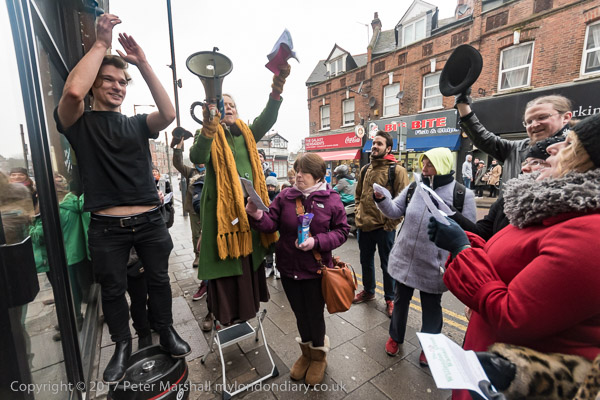
Let all of us take off our hats and shout to the old
Beer & Burger!
more pictures
The 7th Community Wassail in Willesden Green gathered to invoke successful growth and resilience in the neighbourhood, celebrating community initiatives and the shopkeepers who contribute to making the neighbourhood a friendly and happy place.
Based on the traditional wassail in orchards which encouraged apple trees to flourish and bear heavy loads of fruit particularly to make cider, the wassailers toured the area, led by storyteller Rachel Rose Reid and the Cricklewood Community Singers performing a version of the traditional wassail song, with performances by local poets, storytellers and singers at various stops on their way to the crab apple trees behind Willesden Green Library before returning to Tone Coffee Shop for hot drinks and more entertainment.
It was a popular event despite a cold wind, and the performances and wassailing
were good, though I could have done with a little of the traditional cider
on the way, and was sorry that transport problems meant I had to leave as
the rest of the group crowded into (or tried to crowd into) the coffee shop
for hot drinks and more entertainment.
more pictures
Kensal Rise to Willesden Green
Willesden, London. Sun 12 Feb 2017
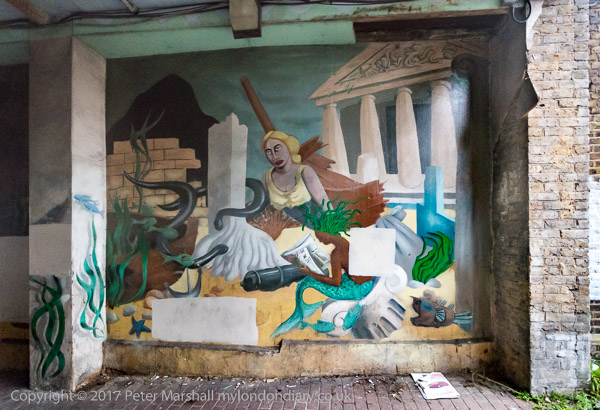
Willesden Green, alley off the High Rd
more pictures
It was really by accident that I got to take a walk for an hour or more through a part of West London, from Kensal Rise station to Willesden Green station.
The Transport for London web site had told me there were no trains running from Staines to Richmond and that I would have to travel by a Rail Replacement bus to Hounslow to catch a slow train there. But when I arrived and bought my ticket there was a train on the platform about to leave, and I jumped on it.
At Richmond too, there was a train sitting in the station, almost ready to go to take me to Kensal Rise, where I arrived just a little over an hour before TfL had told me was possible. It was a cold day, too cold for standing around on the street, and my first thought was to find a pub or cafe close to where the event I was going to photograph would start. But sitting around on my own could be rather boring, and I decided it would be more interesting and I would keep warm enough if I walked rather than take a bus for the final part of my journey.
Since I hadn't intended to walk, I hadn't brought a map, other than Google
Maps on my phone and had done no research. But I knew the most direct route
was too short and decided I could wander a little. In the end I wandered
rather more than intended, and at one point got just a little confused,
turning left when I should have gone right. Things are definitely easier
when following a paper map than one on a phone. I walked around 3 miles
and still got to my destination with about 20 minutes to spare, and just
about kept warm enough.
I took a few more pictures on my way to the bus stop on my way home too,
including the one above. And when I got to Richmond found there were no
trains, instead a replacement bus to Twickenham for a train for there. Travel
is often something of a problem on Sundays.
more pictures
ANAL squat in Belgravia
Grosvenor Gardens, London. Sat 11 Feb 2017
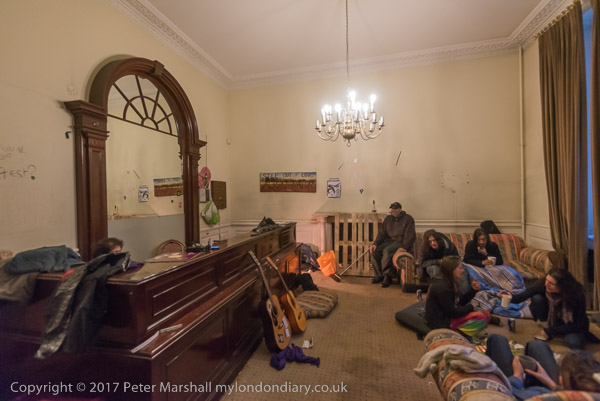
Some of the squatters were in the reception area,
talking and eating
more pictures
Squatting collective the Autonomous Nation of Anarchist Libertarians (ANAL) took over 4 Grosvenor Gardens on Feb 1st after having been evicted from the Belgrave Square house owned by Russian oligarch Andrey Goncharenko which they occupied for a week.
I had hoped to visit them last Saturday along with Class War when there was a programme of workshops and seminars taking place in the seven story building, but unfortunately had to go home to cope with a minor emergency. This week little was happening until later in the day, but I was welcomed by the occupiers who were happy for me to wander around the building and take photographs.
Some of the rooms have been taken over as private spaces by the occupiers, and I respected their privacy, apologising and leaving immediately when I walked in to a couple where people were resting or sleeping. I was able to go from the basement to the topmost floor, but the door leading to the roof was locked, perhaps to stop any possible access from there by bailiffs. Like many other houses and hotels in the area it has a view into the grounds of Buckingham Palace.
The building, which has a blue plaque as the former home of soldier and archaeologist Lieutenant General Augustus Henry Lane Fox Pitt-Rivers, had previously been used for offices, business meetings and conferences, and some traces of the former use remained. Although the occupiers seem to have tried not to cause any real damage, I was told that there had been a few disruptive elements present at the last weekend who had made rather a mess and had been made to leave.
There were slogans, drawings and messages written on the walls (and a blackboard with the message 'No Smack, No Spice') and some areas were untidy, but the interior seemed in fairly good condition as abandoned buildings go, and it was certainly palatial compared to most squats. This is just one of around 1.5 million empty buildings in the UK, many like this deliberately kept empty as investments, their value increasing year on year, enough to house the homeless many times over.
ANAL say that properties like this should be used for short-term accommodation while they remain empty and have opened it as a temporary homeless shelter for rough-sleepers. Although there had been threats of a forced eviction earlier in the week, it appears that there are complications in the ownership of the building that have made this unlikely to happen in the immediate future. They told me they expected to be evicted at the end of the month - and it actually took place around 8am on Feb 27th.
I couldn't stay long but was pleased to have been able to see inside the
place and to briefly discuss the issues with some of the occupiers. There
clearly does need to be some way to bring empty properties back into use,
and councils should have much greater powers than at present to do so. Until
that happens, squatting seems to be the only possible solution.
more pictures
Invest in Cycling - Stop Killing Cyclists
Westminster, London. Sat 11 Feb 2017
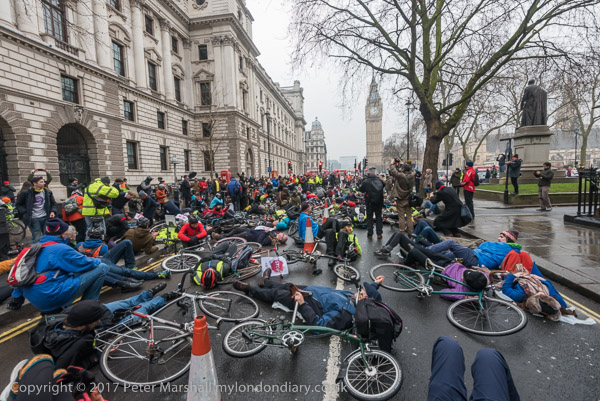
Cyclists die-in in remembrance of the 3 London cyclists
and 2 pedestrians killed this week
more pictures
Cyclists gathered in Trafalgar Square to march down to the treasury calling for a significant increase in spending on infrastructure for cyclists and pedestrians, to reach 10% by 2020.
The protest took place at the end of a week in which 3 cyclists and 2 pedestrians were killed in London and the event remembered cyclists Anita Szucs, Karla Roman, and Ben Wales and the two pedestrians whose names have not yet been released with a die-in and silence.
Currently spending, driven by a powerful motoring and car makers lobby, is almost entirely centred around the needs of car drivers and cutting their journey times through the city. Facilities for cyclists and pedestrians are treated as secondary and are chronically underfunded.
Getting more people to cycle is essential to reducing harmful pollution
and increasing the health of the population, as well as cutting down the
huge contribution transport makes to climate change.
more pictures
Dubs Now - Shame on May
Downing St, London. Sat 11 Feb 2017
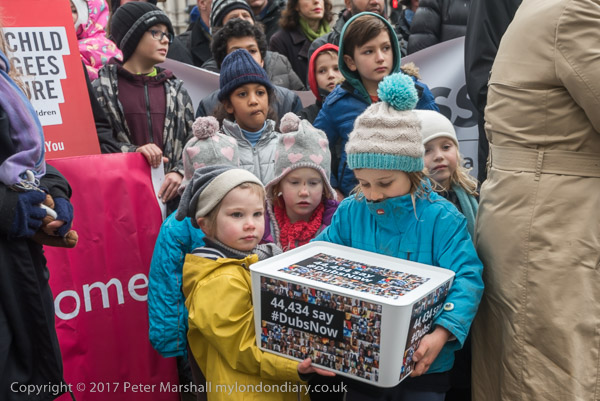
Children hold the box containing the emergency petition
to keep the rescue of children going
more pictures
A crowd of supporters of Citizens UK and Safe Passage joined Lord Alf Dubs at Downing St to take a petition to Theresa May urging her to reverse the decision to stop offering legal sanctuary to unaccompanied refugee children.
When Parliament passed the Dubs amendment the government was given a list of over 800 eligible children (and there were more) but only around 300 have been allowed in and they have announced the scheme is to end.
Speakers from 4 London Labour councils said they had informed the government when the amendment was passed that they could cope with more children but their offers had not been taken up. A speaker from Greenwich COuncil said they had offered places for 23 children and had heard nothing until the morning of this protest when one place had been taken up.
Speakers, including a friend of the late Sir Nicholas Winton who virtually
single handedly rescued 669 children during the Kindertransport, expressed
shock at the shameful and heartless decision announced by the government
and called for them to respect the decision made by Parliament in passing
the Dubs amendment. Alf Dubs also spoke and later carried the box containing
the petition across Whitehall and took it to DOwning St with a small delegation.
more pictures
King's College Divest Oil & Gas Now!
Kings College, Strand, London. Thu 9 Feb 2017
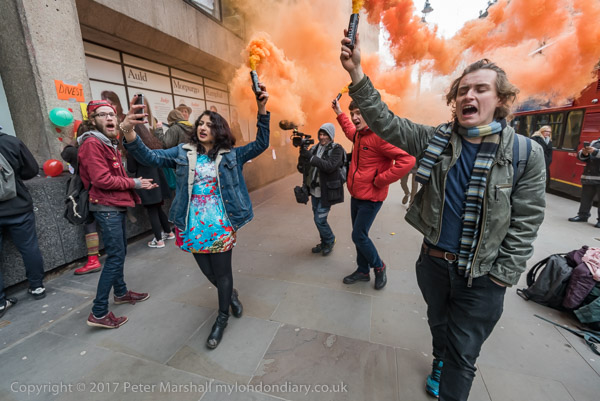
Protesters shout 'Divest Now!' as they walk in front
of King's College holding flares
more pictures
King's College Climate Emergency Group protest on the Strand calling for Kings to be the first of London's Universities to end all investments in fossil fuels and instead invest in renewable energy as a part of a London-wide divestment campaign.
The campaigners stuck balloons, roses and posters along the front of the college and made dots on the columns in wipeable paint in a protest calling for people to 'join up the dots' and realise we need to act urgently to save the world. They were careful to use materials that were readily removed at the end of the protest so that they caused no damage, but apparently were told by the college to stop wiping off the blobs of paint which came off easily with a damp rag.
Kings College reacted against previous protests by suspending PhD student Roger Hallam for writing “Divest From Oil and Gas Now. Out of Time!” on the frontage in a wipe-clean spray, and threatening others. There were two arrests at a previous protest.
Police took details today of several of those who painted the dots and
a college security officer, watched by police, stole the protesters paints
but unlike at the previous protest there were no arrests. The college possibly
stopped the campaigners removing paint at the end of the protest so that
they could claim that this was damage that required special cleaning.
more pictures
Court support for Heathrow protesters
Uxbridge Magistrates Court, Uxbridge, Middx. Tue 7 Feb 2017
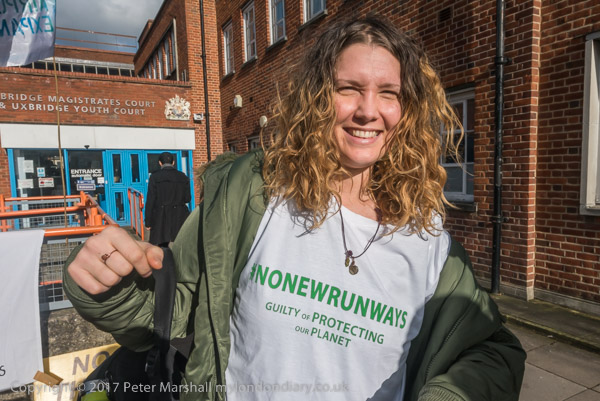
Sophia goes into the court wearing a #NoNewRunways
t-shirt with the message 'Guilty of Protecting the Planet'
more pictures
Around 20 supporters held a picnic outside Uxbridge Magistrates' Court where two protesters, Sophia Lysaczanko and Siân Charnley, who pleaded not guilty to the charge of wilful obstruction after taking part in a road block in protest against Heathrow expansion were to be tried.
The protesters say they felt morally driven to take action and do not feel guilty in the face of the bigger crime that they want to prevent: airport expansion is a red line for climate change, increases already illegally high levels of air pollution and destroys local communities. Sophia made her views clear by wearing a t-shirt with the message '#NoNewRunways - 'Guilty of Protecting the Planet' for her trial.
Police came and talked with the protesters and made clear that they were happy with a peaceful protest outside the court, and arranged for a court official to come out and give some advice about going into the court to watch the trial, suggesting that as some people intended to stay outside it would be simpler to leave bags outside - and that posters, flags and banners were not allowed.
The previous day, magistrates had heard the case against Isabelle, who had changed her plea to guilty; she was given an extra 6 months conditional discharge to those who pleaded guilty at the initial trail in December, making a total of 18 months conditional discharge and the same £105 costs, apparently the minimum that courts charge.
I left as people were going in for the trial to cycle home and file the
pictures. Later I heard that, as expected, Siân and Sophie were both
found guilty. Surprisingly they were given only a 12 month conditional discharge
but the costs for each were higher at £320.
more pictures
No Muslim Ban, No State Visit
US Embassy, London. Sat 4 Feb 2017
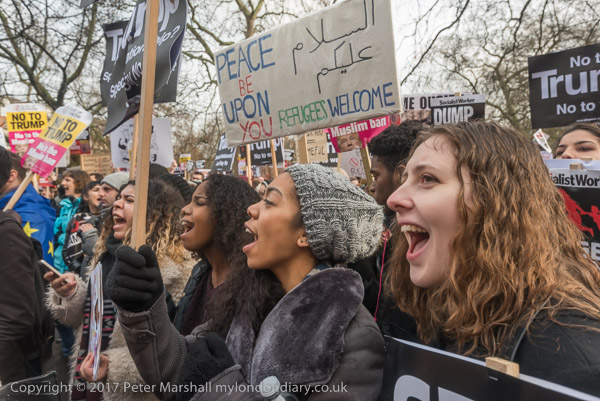
Protesters in front of the embassy shout against Trump's
Muslim ban
more pictures
Thousands of protesters, many with inventive placards, pack into Grosvenor Square in front of the US embassy and in the gardens to listen to speakers including Brent Labour MP Dawn Butler who resigned as shadow minister for diverse communities to vote against the Brexit Bill and NUT General Secretary Kevin Courtney.
Protesters condemned the actions of President Trump and Theresa May, calling for Trump to end his Muslim ban and for May to withdraw the invitation to a State Visit here.
After the rally they were to march to Downing St and a further rally in
Whitehall. Unfortunately I got a phone call from home and had to rush back
there to deal with a minor emergency.
more pictures
London Images
February 2017
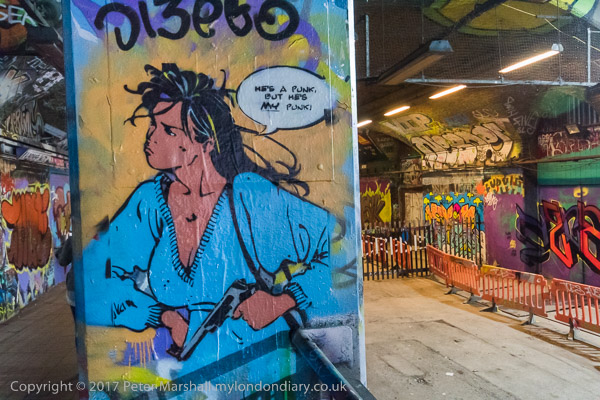
Graffiti in Leake St
more pictures
top of page
All pictures on this site are Copyright
© 1999-2019 Peter Marshall ; all rights reserved.
for licences to reproduce pictures or to buy prints or comment on the work,
Payment may be waived for acceptable non-profit
use by unfunded bodies.
But organisations that pay any staff should also pay photographers.